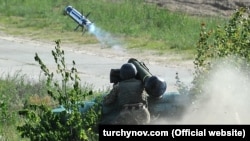Over the five years of grinding war that has pitted Ukrainian forces against Russia-backed fighters, the United States has provided hundreds of millions of dollars in military gear: night-vision goggles, flak jackets, vehicles, counter-battery radars, among other things.
Last year, after years of internal debate that preceded his administration, President Donald Trump began supplying Ukraine with sophisticated anti-tank missiles known as Javelins -- a move that some feared would antagonize Moscow.
Now, U.S. lawmakers are moving to up the ante again, with legislation that would authorize supplying Kyiv with surface-to-air missiles.
The effort comes in an amendment being attached to legislation providing funding for the Defense Department; the amendment removes existing language prohibiting the sale of such missiles, known as man-portable air-defense systems, or MANPADS.
Sponsored by the two top lawmakers on the House Foreign Affairs Committee -- Democrat Eliot Engel and Republican Michael McCaul -- the measure, which is expected to pass easily, does not mean that the weapons will be supplied right away.
Any final decision would have to go through multiple approval processes at various U.S. agencies, including the U.S. Defense Department.
Moreover, targets for Ukrainian surface-to-air missiles are limited for now: Russia-backed separatists don’t have fighter jets, and Russia sending its own aircraft over Ukraine would undermine its assertions that it is not involved in the conflict.
Still, the move sends a clear message to the Kremlin of where Congress stands regarding the war in Ukraine. And, according to Steven Pifer, a former U.S. ambassador to Ukraine, it's a logical next step after the U.S. decision to supply Javelins to the Ukrainian armed forces.
"I don't see this as generating more problems than the arrival of the Javelins did," Pifer, now a research fellow at Stanford University's Freeman Spogli Institute for International Studies, told RFE/RL. "We're not talking about providing the Ukrainians with F-35 fighters or M-1 tanks."
The Defense Department did not immediately respond to a query seeking comment on the possibility of supplying the missiles.
One U.S. diplomat who has worked on Ukraine-related issues downplayed the significance of the amendment, telling RFE/RL on the condition of anonymity in order to speak freely that it simply removed "an arbitrary restriction that is not in place for most countries."
The move comes as part of a broader effort in Congress to increase military support for Ukraine. Two separate pieces of legislation making their way through the House and the Senate call for authorizing up to $300 million in annual military support for Ukraine, an increase from past years.
And the House legislation calls for the first time for supplying anti-ship missiles and coastal-defense weaponry to Ukraine in response to an incident in November 2018, when Russian Coast Guard ships seized three Ukrainian boats and 24 sailors in the Kerch Strait near the Crimean Peninsula.
Though the overall death toll has surpassed 13,000, fighting around Ukraine's Donbas region has ebbed and flowed in intensity since 2014, when the conflict with Russia first erupted.
In recent weeks, there's been a sharp uptick in artillery shelling and gunfire, with Ukraine's military reporting that at least six soldiers were killed last week.
It's unclear how Russia would respond if Washington did in fact move forward to supply the surface-to-air missiles.
And it's unclear how that would affect stalled peace negotiations, including the so-called Minsk Trilateral Contact Group meetings and the Normandy Format talks. Ukraine's newly elected president, Volodymyr Zelenskiy, has called for restarting both efforts; last week, the Trilateral Group -- comprised of officials from Russia, Ukraine, and the Organization for Security and Cooperation in Europe -- met for the first time in weeks.
But Konstantin Kosachyov, a member of Russia's upper house of parliament and a Kremlin ally, criticized the overall increase in U.S. military funding for Ukraine.
"In this way Washington fuels Ukraine's internal conflict. Such foreign support may create a dangerous delusion in Kiev that a solution can be achieved by military means," Kosachyov said in a post to his Facebook page on June 11. "Each million dollars of military support to Kiev spells more casualties and months and even years of war against one’s own people, for which the United States will bear its share of responsibility."
The MANPADS would have no immediate battlefield use, Pifer noted, since Russian military aircraft have not been used in the conflict. Drones, however, are widely used by both sides in the conflict.
While Moscow reacted angrily when Washington agreed to supply the Javelins to Ukraine, there have been few remarks by Russian officials on the subject since the 210 missiles and 37 launchers arrived in April 2018.
Ukraine has showcased the Javelins in publicized drills but its armed forces have not used them in combat against Russia-backed forces in eastern battlefields.
The special U.S. envoy for Ukraine, Kurt Volker, has said that the Javelins are being stored in a secure facility far from the front line.
Ukrainian and U.S. sources with knowledge of the storage locations have told RFE/RL that the missiles and launchers have been separated into smaller groups and are held in strategic locations around the country, possibly in underground bunkers, where they can be moved quickly to areas that border Russia or the eastern front line.
In March, the top U.S. military commander for Europe told the Senate Armed Services Committee that even if the Javelins hadn't been deployed, their presence had been registered by Russia-backed forces.
"They take that into consideration in the deployment of their forces and where they put them," General Curtis Scaparrotti told the committee.
Since 2014, Ukraine has received more than $3 billion in total support, including security and nonsecurity assistance, from the United States.











